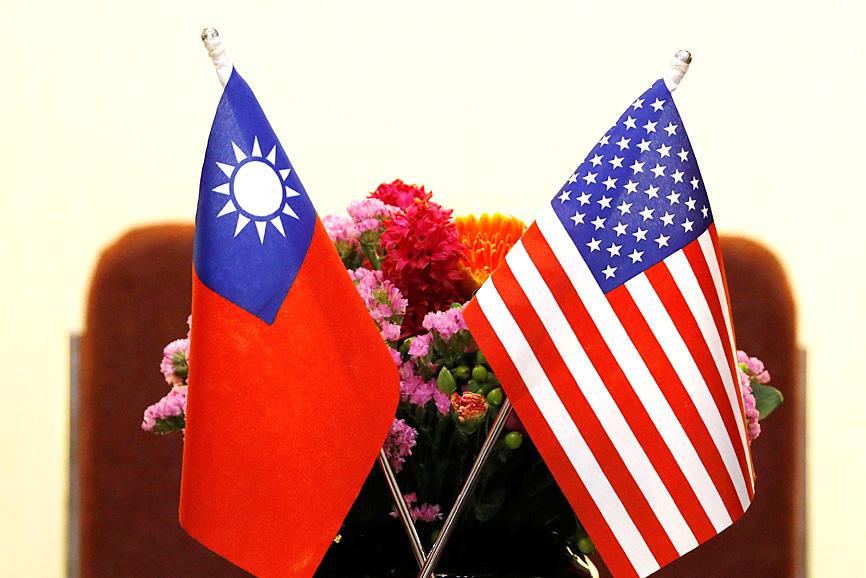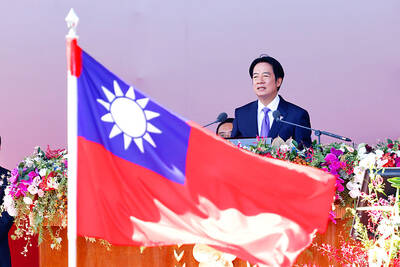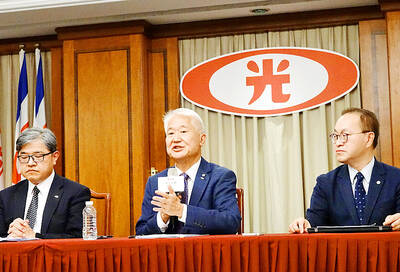Two hundred US lawmakers in a letter on Wednesday called for Taiwan’s participation in the planned Indo-Pacific Economic Framework (IPEF), touting the nation’s economic importance and the signal of support it would send to counter Chinese intimidation.
The letter, drafted by the four cochairs of the Congressional Taiwan Caucus and addressed to US Secretary of Commerce Gina Raimondo and US Trade Representative Katherine Tai (戴琪), said that Taiwan should be “at the front of the line” to join the framework.
US President Joe Biden in October last year proposed the IPEF to boost economic cooperation with Indo-Pacific partners.

Photo: Tyrone Siu, Reuters
The move is considered to be Washington’s latest effort at countering growing Chinese influence in the region in the wake of its withdrawal from the Trans-Pacific Partnership in 2017.
Calling the reasons for including Taiwan “compelling,” the letter outlined the nation’s strengths as a major Indo-Pacific economy.
It not only served as the eighth-largest trading partner to the US last year with US$114 billion in total volume, but has also aided in diversifying the US supply chain away from overdependence on the People’s Republic of China (PRC), the letter said.
It also highlighted economic engagement with Taiwan through the US-Taiwan Economic Prosperity Partnership Dialogue — which covers topics similar to those considered for the IPEF — and the Global Cooperation and Training Framework (GCTF), which also includes Japan and Australia as full partners.
Other regional economies should also welcome Taiwan’s participation, considering its active membership in APEC since 1991, and facilitation of trade and investment liberalization, it said.
Taiwan’s expertise in inviting thousands of participants to the GCTF “would also enhance the likelihood of a successful outcome of the IPEF deliberations,” it added.
“For these reasons alone, we believe that Taiwan should be at the front of the line to be invited to participate in the IPEF,” it said. “Taiwan’s inclusion would also send a clear signal that the United States stands with its allies and partners, and will not be bullied by the PRC.”
“Mindful of Russia’s ongoing war on Ukraine, it is critically important for the United States to unequivocally support Taiwan as it confronts an increasingly bellicose PRC,” it said. “Taiwan’s admission to the IPEF would be an essential step in demonstrating America’s resolve to protect, defend and strengthen that key partnership.”
The Ministry of Foreign Affairs yesterday thanked the bipartisan group of lawmakers for their support.
Taiwan participates in regional economic affairs, and is committed to deepening economic ties with the US and other like-minded partners, ministry spokeswoman Joanne Ou (歐江安) said.
Additional reporting by Lu Yi-hsuan

People can preregister to receive their NT$10,000 (US$325) cash distributed from the central government on Nov. 5 after President William Lai (賴清德) yesterday signed the Special Budget for Strengthening Economic, Social and National Security Resilience, the Executive Yuan told a news conference last night. The special budget, passed by the Legislative Yuan on Friday last week with a cash handout budget of NT$236 billion, was officially submitted to the Executive Yuan and the Presidential Office yesterday afternoon. People can register through the official Web site at https://10000.gov.tw to have the funds deposited into their bank accounts, withdraw the funds at automated teller

PEACE AND STABILITY: Maintaining the cross-strait ‘status quo’ has long been the government’s position, the Ministry of Foreign Affairs said Taiwan is committed to maintaining the cross-strait “status quo” and seeks no escalation of tensions, the Ministry of Foreign Affairs (MOFA) said yesterday, rebutting a Time magazine opinion piece that described President William Lai (賴清德) as a “reckless leader.” The article, titled “The US Must Beware of Taiwan’s Reckless Leader,” was written by Lyle Goldstein, director of the Asia Program at the Washington-based Defense Priorities think tank. Goldstein wrote that Taiwan is “the world’s most dangerous flashpoint” amid ongoing conflicts in the Middle East and Russia’s invasion of Ukraine. He said that the situation in the Taiwan Strait has become less stable

CONCESSION: A Shin Kong official said that the firm was ‘willing to contribute’ to the nation, as the move would enable Nvidia Crop to build its headquarters in Taiwan Shin Kong Life Insurance Co (新光人壽) yesterday said it would relinquish land-use rights, or known as surface rights, for two plots in Taipei’s Beitou District (北投), paving the way for Nvidia Corp to expand its office footprint in Taiwan. The insurer said it made the decision “in the interest of the nation’s greater good” and would not seek compensation from taxpayers for potential future losses, calling the move a gesture to resolve a months-long impasse among the insurer, the Taipei City Government and the US chip giant. “The decision was made on the condition that the Taipei City Government reimburses the related

FRESH LOOK: A committee would gather expert and public input on the themes and visual motifs that would appear on the notes, the central bank governor said The central bank has launched a comprehensive redesign of New Taiwan dollar banknotes to enhance anti-counterfeiting measures, improve accessibility and align the bills with global sustainability standards, Governor Yang Chin-long (楊金龍) told a meeting of the legislature’s Finance Committee yesterday. The overhaul would affect all five denominations — NT$100, NT$200, NT$500, NT$1,000 and NT$2,000 notes — but not coins, Yang said. It would be the first major update to the banknotes in 24 years, as the current series, introduced in 2001, has remained in circulation amid rapid advances in printing technology and security standards. “Updating the notes is essential to safeguard the integrity